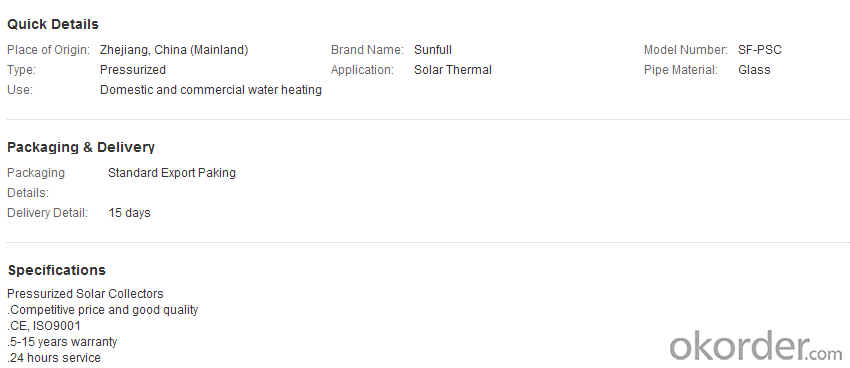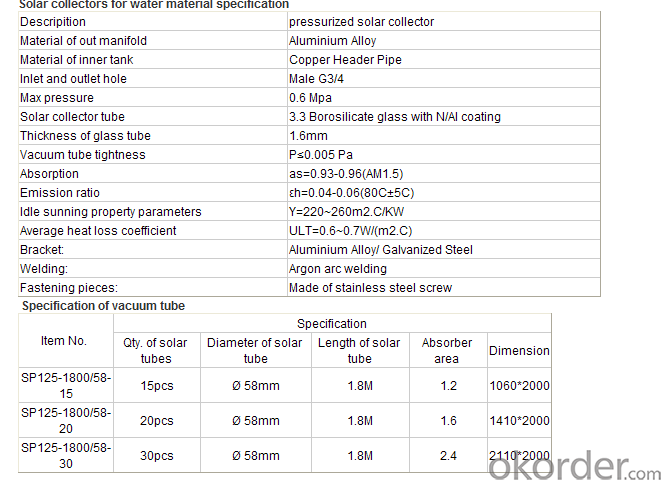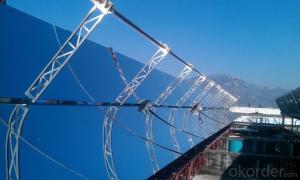Pressurized Solar Collector with Heat Pump
- Loading Port:
- Shanghai
- Payment Terms:
- TT or LC
- Min Order Qty:
- 100 m²
- Supply Capability:
- 100000 m²/month
OKorder Service Pledge
OKorder Financial Service
You Might Also Like
Descritpion:
CNBM Solar is a world-leading and Vertical integrated manufacturer of high-performance with Silicon,
Wafer, Cells, Modules, which convert sunlight into electricity for residential, commercial, and utility-scale
power generation.
The capacity of CNBMSolar is reach to 1GW, and make sure each year our shipment capacity is more
Than 700-800MWs, at the same time, we have set up the largest solar power station with our partner
in Ukraine.
CNBM is a Quality + Service oriented company with“Excellence at Each Step” approach, composed of
the finest components from TUV and IEC-certified partners around the world, CNBM modules consistently
undergo a variety of trials at the company’s Test & Development Centre, ensuring peak performance
capabilities. The company is committed to develop and provide the world with clean and renewable energy
to ease the energy shortages as well as human kind’s impact on the environment.



FAQ:What's CNBM's strength?
CNBM Group is short for China National Building Materials Group Corporation, which is established in 1984 with approval from the State Council. It is a China state owned company ,one of Global Fortune 500 .SO,CNBM can get more support from government .
- Q:Can solar energy systems be leased or rented?
- Yes, solar energy systems can be leased or rented. Leasing or renting solar panels allows individuals or businesses to access the benefits of solar energy without the upfront costs of purchasing the system. This option is especially popular for those who may not have the financial resources to buy a solar energy system outright.
- Q:Can a solar energy system be connected to the grid?
- Yes, a solar energy system can be connected to the grid. In fact, many solar energy systems are designed to be grid-tied, allowing excess electricity generated by the system to be fed back into the grid. This enables homeowners and businesses to earn credits for the surplus energy produced and use it when their solar panels are not generating electricity, such as during nighttime or cloudy days. Grid connection also provides a reliable backup power source when solar production is insufficient.
- Q:Can solar energy be used in cloudy climates?
- Yes, solar energy can still be used in cloudy climates. While the efficiency of solar panels may be slightly reduced in overcast conditions, they can still generate electricity. Additionally, advancements in technology, such as the use of bifacial solar panels, have made it possible to capture sunlight from multiple angles, allowing solar energy to be harnessed even in cloudy weather.
- Q:Can solar energy systems be used in areas with high levels of wildlife activity?
- Yes, solar energy systems can be used in areas with high levels of wildlife activity. While it is true that wildlife can pose some challenges for solar energy systems, there are several ways to mitigate these issues. One of the primary concerns is the risk of damage to the solar panels by large animals or birds. However, there are various protective measures that can be taken to prevent this. For instance, installing fencing or barriers around the solar panels can help keep wildlife away. Additionally, using anti-reflective coatings on the panels can reduce the likelihood of bird collisions. Another concern is the impact of solar energy systems on wildlife habitats. It is crucial to choose the location of the solar panels carefully, considering the existing wildlife activity in the area. By conducting thorough environmental impact assessments and engaging with local wildlife experts, it is possible to minimize any potential negative effects on wildlife habitats. Moreover, solar energy systems can actually benefit wildlife in some cases. For example, solar farms can provide additional shelter and shade for some species, and the open spaces underneath the panels can create new habitats for ground-dwelling animals. Overall, while there may be some challenges, with proper planning and mitigation strategies, solar energy systems can be successfully utilized in areas with high levels of wildlife activity.
- Q:Can solar energy systems be used in powering car charging stations?
- Car charging stations can definitely be powered by solar energy systems. Actually, many car charging stations worldwide already rely on solar energy. Solar panels can be placed on the roof or in close proximity to the charging station, capturing sunlight and converting it into electricity. This renewable energy can then be used to charge electric vehicles (EVs) without depending on the traditional power grid. Solar-powered car charging stations have several advantages. Firstly, they provide a sustainable and clean energy source, reducing carbon emissions and the overall environmental impact of EVs. Secondly, they can be installed in remote or off-grid areas where connecting to the electrical grid may be difficult or costly. This makes solar-powered charging stations especially beneficial for rural regions or highways lacking easy access to electricity. Additionally, solar energy systems can incorporate battery storage, enabling excess energy generated during the day to be stored and utilized during the night or periods of high demand. This guarantees a continuous and reliable power source for car charging stations, even in the absence of sunlight. Although the initial installation cost of solar energy systems may be higher when compared to traditional power sources, their long-term operating and maintenance costs are generally lower. Moreover, there are various government incentives and rebates available to promote the use of renewable energy, which can help offset these initial expenses. All in all, solar energy systems offer a viable and sustainable solution for powering car charging stations, providing environmental benefits, energy independence, and long-term cost savings.
- Q:How do solar energy systems reduce carbon emissions?
- Solar energy systems reduce carbon emissions by converting sunlight into electricity or heat without burning any fossil fuels. Unlike traditional energy sources such as coal or natural gas, solar energy does not release any greenhouse gases or pollutants into the atmosphere during operation. This means that using solar energy reduces the dependence on fossil fuels, which are major contributors to carbon emissions and climate change. By harnessing the power of the sun, solar energy systems help to mitigate the environmental impact of energy production and promote a cleaner and more sustainable future.
- Q:How does the size of a solar energy system affect its output?
- The size of a solar energy system directly affects its output. A larger system will generally produce more energy compared to a smaller one, as it has a greater capacity to capture and convert sunlight into electricity. The number and efficiency of solar panels in the system, along with other components such as inverters and batteries, determine the overall output.
- Q:How do solar energy systems impact the overall energy independence of a building?
- Solar energy systems can significantly increase the overall energy independence of a building. By harnessing the power of the sun, these systems generate clean and renewable electricity, reducing the reliance on traditional energy sources. With solar panels installed, buildings can produce their own energy, thereby decreasing dependence on the grid and potentially eliminating or significantly reducing electricity bills. This not only helps in achieving energy self-sufficiency but also contributes to a more sustainable and environmentally-friendly future.
- Q:What is the impact of shading on solar energy systems?
- Shading has a significant impact on solar energy systems as it can reduce the overall efficiency and output of the system. When a solar panel or array is shaded, it blocks the sunlight from reaching the photovoltaic cells, resulting in a decrease in electrical generation. Even partial shading, such as from trees or nearby buildings, can have a noticeable effect on the system's performance. It is important to design and install solar energy systems in areas with minimal shading to maximize their energy production potential.
- Q:Can solar energy systems be used for powering electric plane systems?
- Yes, solar energy systems can be used for powering electric plane systems. Solar panels can be mounted on the surface of the plane to capture sunlight and convert it into electricity. This electricity can then be used to power various systems on the plane, such as its propulsion, navigation, and communication systems. However, it is important to note that currently, solar energy alone may not be sufficient to power an entire electric plane during flight, as planes require significant amounts of energy. Nevertheless, solar energy can be a valuable supplement to reduce fuel consumption and emissions in electric planes.
1. Manufacturer Overview |
|
|---|---|
| Location | |
| Year Established | |
| Annual Output Value | |
| Main Markets | |
| Company Certifications | |
2. Manufacturer Certificates |
|
|---|---|
| a) Certification Name | |
| Range | |
| Reference | |
| Validity Period | |
3. Manufacturer Capability |
|
|---|---|
| a)Trade Capacity | |
| Nearest Port | |
| Export Percentage | |
| No.of Employees in Trade Department | |
| Language Spoken: | |
| b)Factory Information | |
| Factory Size: | |
| No. of Production Lines | |
| Contract Manufacturing | |
| Product Price Range | |
Send your message to us
Pressurized Solar Collector with Heat Pump
- Loading Port:
- Shanghai
- Payment Terms:
- TT or LC
- Min Order Qty:
- 100 m²
- Supply Capability:
- 100000 m²/month
OKorder Service Pledge
OKorder Financial Service
Similar products
New products
Hot products
Related keywords





























